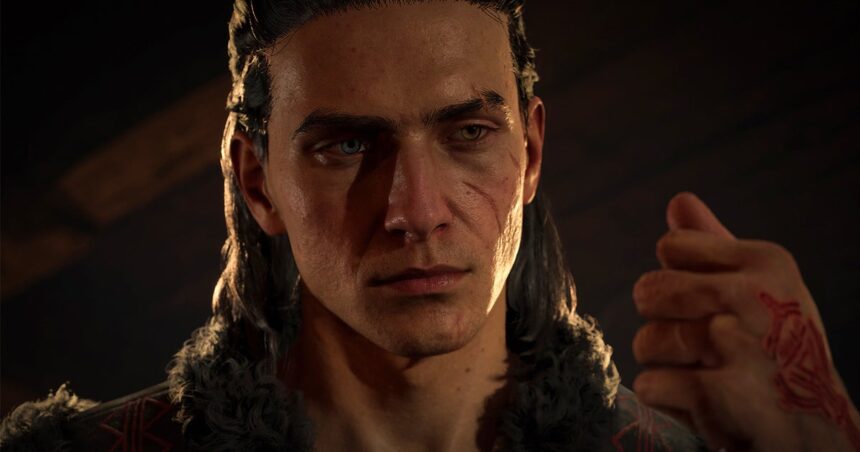There’s so much I like about Blood of the Dawnwalker. It turned my head earlier in the summer when a debut gameplay trailer was released, and my head is still firmly turned – spun like Linda Blair’s in The Exorcist – now that I’ve watched a gamescom presentation for it. It’s part Witcher, part Vampire, part Kingdom Come, and if the modest Polish team can deliver what it’s promising, Blood of the Dawnwalker could be great.
Quick recap: Blood of the Dawnwalker is the debut game by Rebel Wolves, a studio co-created by Witcher 3 game director Konrad Tomaszkiewicz, and fitted out with a number of former CD Projekt Red colleagues, including his brother Mateusz, the lead quest designer of The Witcher 3, Jakub Szalamek, one of the lead writers on The Witcher 3, and many others. LinkedIn counts 134 people there, which makes it a sizable operation already. The similarities to The Witcher 3 are not unexpected, then, and you only need to see the game in action for a few moments to appreciate why.
Again, we are a ponytailed warrior exploring a fantastical but grounded fuedal medieval land, one populated by worn down peasants who cuss and complain as they pass you by. Again, we mutter to ourselves as we explore, and we often solve situations with a longsword wielded in two hands, dispatching groups of bandits and guards and whoever stands in our way. But also like The Witcher, there are supernatural forces at play – darker things lurking underneath the facade of the region we explore – and once again we are a supernaturally capable hero capable of taking them on. So much is familiar: the tone of the game, the way it plays, the sensibilities that underpin it. But there are important differences too.
In Blood of the Dawnwalker we’re a vampire, but a vampire with a difference. We’re a Dawnwalker, which is to say, we’re a hybrid – part-vampire, part-human, a bit like Blade in Marvel’s comics. This allows us to do things like, as the name suggests, walk in the sunlight. But our hybrid nature is also tied to the time of day. Put simply, in the day we’re a human capable of mostly human things, whereas at night, we’re a vampire capable of vampire things, and the entire game is built around this idea, this duality. Situations can be solved differently at night than they can in the day.
The gameplay demo released earlier in the summer shows a lot of this in action, and the Gamescom presentation I watch takes place in the same place, but is extended to take us underneath the cathedral where an important secret can be found. Changes have also been made to the game since the earlier showcase, namely the addition of a “far” camera to complement the “close” one, upon request of the growing community around the game. The point of the presentation is to underscore the game’s sandbox approach to completing quests, so we’re shown two approaches to finding the secret under the cathedral – one at night and one during the day. Or in other words: one as a vampire and one as a human.
.jpg?width=690&quality=70&format=jpg&auto=webp)
.jpg?width=690&quality=70&format=jpg&auto=webp)
.jpg?width=690&quality=70&format=jpg&auto=webp)
As a vampire, we can do extraordinary things. We can – and I love this – Plane Shift by pointing at a surface somewhere and teleporting or shifting to it. This also orientates us correctly upon that surface, such that if we point at a wall, we’ll find ourselves standing on it and able to walk up or down it. Think Batman and Robin scaling a building in the old Adam West Batman series. We also have no need for a sword as a vampire because we can use our clawed hands instead, and we can glomp onto enemies with our fangs and drain their blood. As a vampire, then, the rooftop playground of the city is available to us, and we can find an open window into the cathedral at night and infiltrate it that way.
While up in the rafters of the cathedral, we can ignore the blood ritual going on below us – the ritual we disturbed in the summer showcase to trigger a boss battle – and instead find a fresco on the ceiling and examine it to learn about the symbol of a Saint. We then crosscheck this symbol with a book found in a library nearby and learn about the whereabouts of a gravestone we need to lift in order to get down into the catacombs below.
By day it’s a different matter. We can walk directly into the cathedral this time and sit through a service there, but we also need to talk to people to achieve our ends – first the glassy-eyed Abbot who was just baptising an infant with blood (vampires are a known and ruling force in this world) – and then to a Deacon who’s cleaning an altar. The Deacon will ask us to solve a gruesome mystery in a nearby almshouse, which sounds very Witchery and is – it even involves using Witcher-like senses to highlight clues – before giving us the clue we need to find the grave to the catacombs. So you see: two different (and hastily condensed by me) routes to achieving the same end, and one that takes longer than the other. Which begs the question: why wouldn’t we always wait until night time to be a vampire and achieve our goals?
.jpg?width=690&quality=70&format=jpg&auto=webp)
.jpg?width=690&quality=70&format=jpg&auto=webp)
Two answers. One: some quests have to be tackled at a certain time of day. Two: time itself. You don’t have much of it. The entire main-quest premise of the game is that you have 22 days to save your family, I’m not sure from what – vampires probably. Anything that significantly moves a quest on will cost time, and you’ll see this denoted by an hourglass and number next to any option you take. You won’t move time on by generally milling around in the world, exploring, fighting and looting. Opening the grave to get into the catacombs cost one small bar of time, for example, which pushed me closer from day to night.
Another slight time pressure is exerted in dialogue by an emptying time gauge, which hurries you to make decisions. But again, this only happens in dramatically important conversations. It doesn’t happen all the time. And I like this sense of time ticking down and the urgency it infuses the game with. It’s also a good way for the game to encourage you not to waste time and tackle solutions as both human and vampire.
To see this content please enable targeting cookies.
Ironically, given that, Blood of the Dawnwalker seems to be a fairly slow-paced game. The sandbox aspirations of it, and the ability to go about situations as you wish, mean there can be a lot of poking around before you find what you’re supposed to do. Clues can be well hidden. There was one instance where the symbol Coen was looking for was hidden on the bottom of a golden chalice in a room of a building I had to locate first. And even when it was found, it had to be picked up and turned over before the symbol could be seen. Blood of the Dawnwalker seems to be a bit like this; even examining the fresco earlier involved several points of interest that had to be interacted with. On the one hand, I like this, because it shows trust in the player by making them slow down and think. But I can also imagine the game becoming laborious if everything pans out this way.
There’s a sedateness that spreads from the main character Coen, too, both in how they’re written and in the way they’re voiced by English language actor Will de Renzy-Martin. I kid you not, he narrates sleep stories, and you need only listen to him talk to hear why: his purring tones are like a snuggly blanket, a bit Tom Hiddleston-esque. And I adore calm characters and performances like this.
There’s so much about Blood of the Dawnwalker to get excited by. The intriguing dual-character premise and the unique shape it gives the game; a gruesome supernatural story about vampires and monsters based in a historically accurate and carefully recreated world; and clever gameplay evolutions like having both an easier one-button block and strike combat mechanic, alongside a trickier directional one. The Witcher comparisons are obvious, then, and they’re probably very welcome, but there’s more going on here too. There’s a sense of evolution, of the people who made that game getting together and thinking about what they could do differently while evoking the same kind of feeling. And yes, they clearly don’t have the same resources as CD Projekt Red, but they have the ambition. And should they be able to pull it off, this might be another significant Polish success.





